BUSI 343 Case Study: Employee and Labor Relations Analysis
VerifiedAdded on 2022/11/27
|5
|1174
|98
Case Study
AI Summary
This case study examines the concept of employee voice within a non-union business context, focusing on the strategies employed by Human Resource managers to foster employee engagement and satisfaction. It explores various employee voice mechanisms, differentiating between direct and indirect approaches, as well as formal and informal methods. The analysis delves into the structure of these mechanisms, such as anonymous employee surveys, and the strategies for ensuring their success, like building trust and aligning organizational policies with employee needs. The study contrasts the effectiveness of these strategies with the potential impact of a unionized environment. Furthermore, it reflects on the balance between employee and company perspectives, arguing for employee voice as a fundamental human right. The study also references the story of Daniel as a parallel to maintaining beliefs and rights in difficult situations.
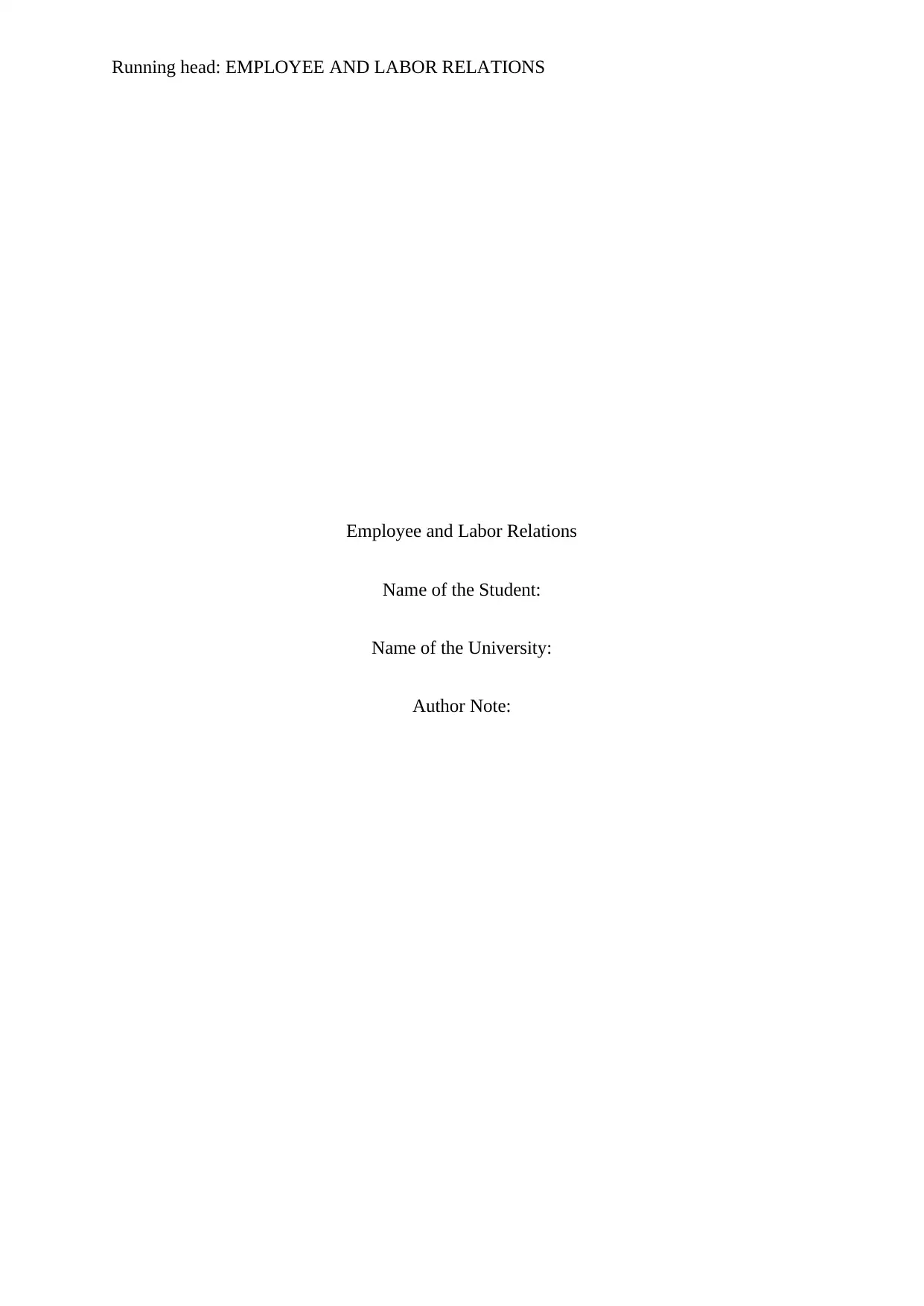
Running head: EMPLOYEE AND LABOR RELATIONS
Employee and Labor Relations
Name of the Student:
Name of the University:
Author Note:
Employee and Labor Relations
Name of the Student:
Name of the University:
Author Note:
Paraphrase This Document
Need a fresh take? Get an instant paraphrase of this document with our AI Paraphraser
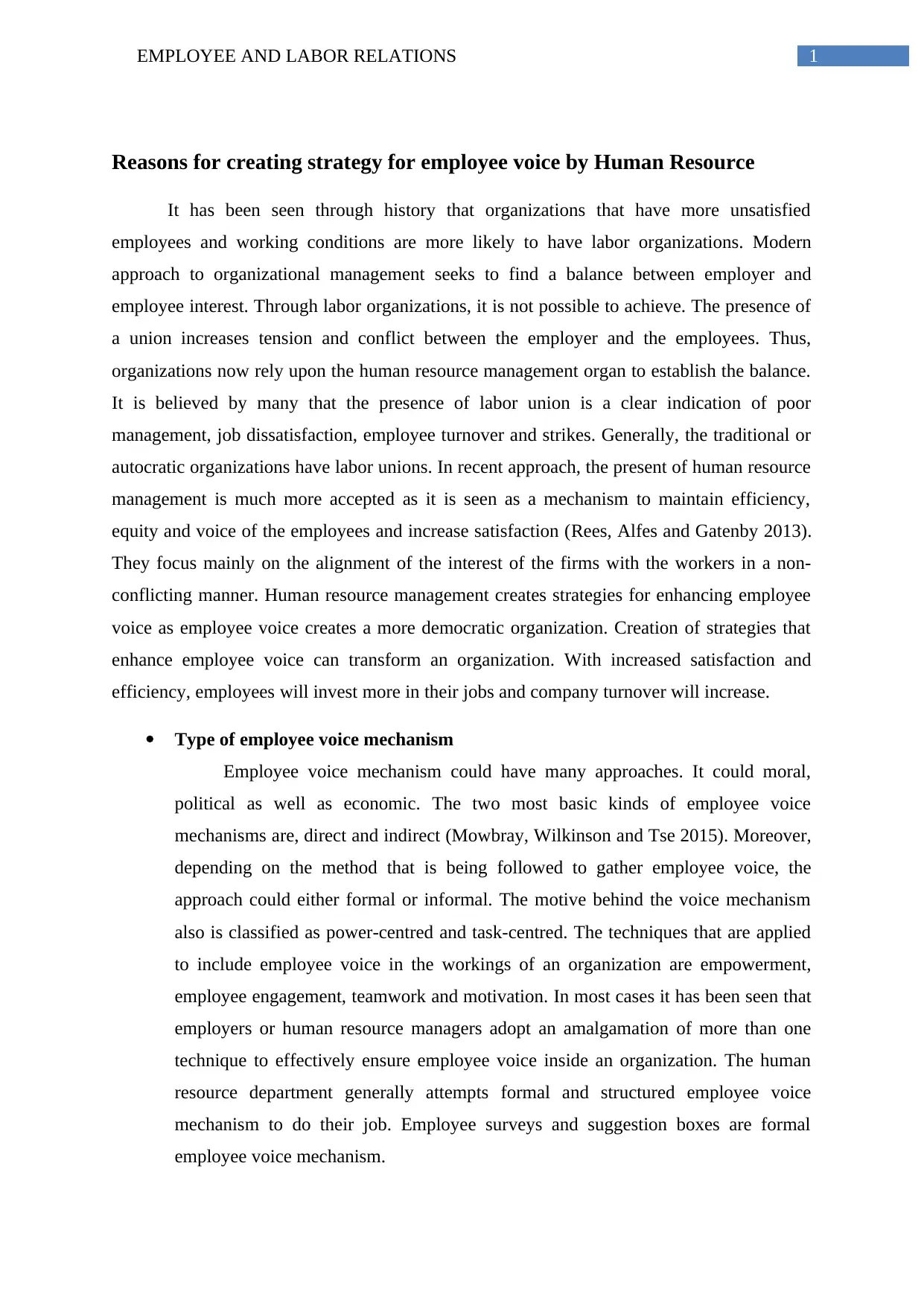
1EMPLOYEE AND LABOR RELATIONS
Reasons for creating strategy for employee voice by Human Resource
It has been seen through history that organizations that have more unsatisfied
employees and working conditions are more likely to have labor organizations. Modern
approach to organizational management seeks to find a balance between employer and
employee interest. Through labor organizations, it is not possible to achieve. The presence of
a union increases tension and conflict between the employer and the employees. Thus,
organizations now rely upon the human resource management organ to establish the balance.
It is believed by many that the presence of labor union is a clear indication of poor
management, job dissatisfaction, employee turnover and strikes. Generally, the traditional or
autocratic organizations have labor unions. In recent approach, the present of human resource
management is much more accepted as it is seen as a mechanism to maintain efficiency,
equity and voice of the employees and increase satisfaction (Rees, Alfes and Gatenby 2013).
They focus mainly on the alignment of the interest of the firms with the workers in a non-
conflicting manner. Human resource management creates strategies for enhancing employee
voice as employee voice creates a more democratic organization. Creation of strategies that
enhance employee voice can transform an organization. With increased satisfaction and
efficiency, employees will invest more in their jobs and company turnover will increase.
Type of employee voice mechanism
Employee voice mechanism could have many approaches. It could moral,
political as well as economic. The two most basic kinds of employee voice
mechanisms are, direct and indirect (Mowbray, Wilkinson and Tse 2015). Moreover,
depending on the method that is being followed to gather employee voice, the
approach could either formal or informal. The motive behind the voice mechanism
also is classified as power-centred and task-centred. The techniques that are applied
to include employee voice in the workings of an organization are empowerment,
employee engagement, teamwork and motivation. In most cases it has been seen that
employers or human resource managers adopt an amalgamation of more than one
technique to effectively ensure employee voice inside an organization. The human
resource department generally attempts formal and structured employee voice
mechanism to do their job. Employee surveys and suggestion boxes are formal
employee voice mechanism.
Reasons for creating strategy for employee voice by Human Resource
It has been seen through history that organizations that have more unsatisfied
employees and working conditions are more likely to have labor organizations. Modern
approach to organizational management seeks to find a balance between employer and
employee interest. Through labor organizations, it is not possible to achieve. The presence of
a union increases tension and conflict between the employer and the employees. Thus,
organizations now rely upon the human resource management organ to establish the balance.
It is believed by many that the presence of labor union is a clear indication of poor
management, job dissatisfaction, employee turnover and strikes. Generally, the traditional or
autocratic organizations have labor unions. In recent approach, the present of human resource
management is much more accepted as it is seen as a mechanism to maintain efficiency,
equity and voice of the employees and increase satisfaction (Rees, Alfes and Gatenby 2013).
They focus mainly on the alignment of the interest of the firms with the workers in a non-
conflicting manner. Human resource management creates strategies for enhancing employee
voice as employee voice creates a more democratic organization. Creation of strategies that
enhance employee voice can transform an organization. With increased satisfaction and
efficiency, employees will invest more in their jobs and company turnover will increase.
Type of employee voice mechanism
Employee voice mechanism could have many approaches. It could moral,
political as well as economic. The two most basic kinds of employee voice
mechanisms are, direct and indirect (Mowbray, Wilkinson and Tse 2015). Moreover,
depending on the method that is being followed to gather employee voice, the
approach could either formal or informal. The motive behind the voice mechanism
also is classified as power-centred and task-centred. The techniques that are applied
to include employee voice in the workings of an organization are empowerment,
employee engagement, teamwork and motivation. In most cases it has been seen that
employers or human resource managers adopt an amalgamation of more than one
technique to effectively ensure employee voice inside an organization. The human
resource department generally attempts formal and structured employee voice
mechanism to do their job. Employee surveys and suggestion boxes are formal
employee voice mechanism.
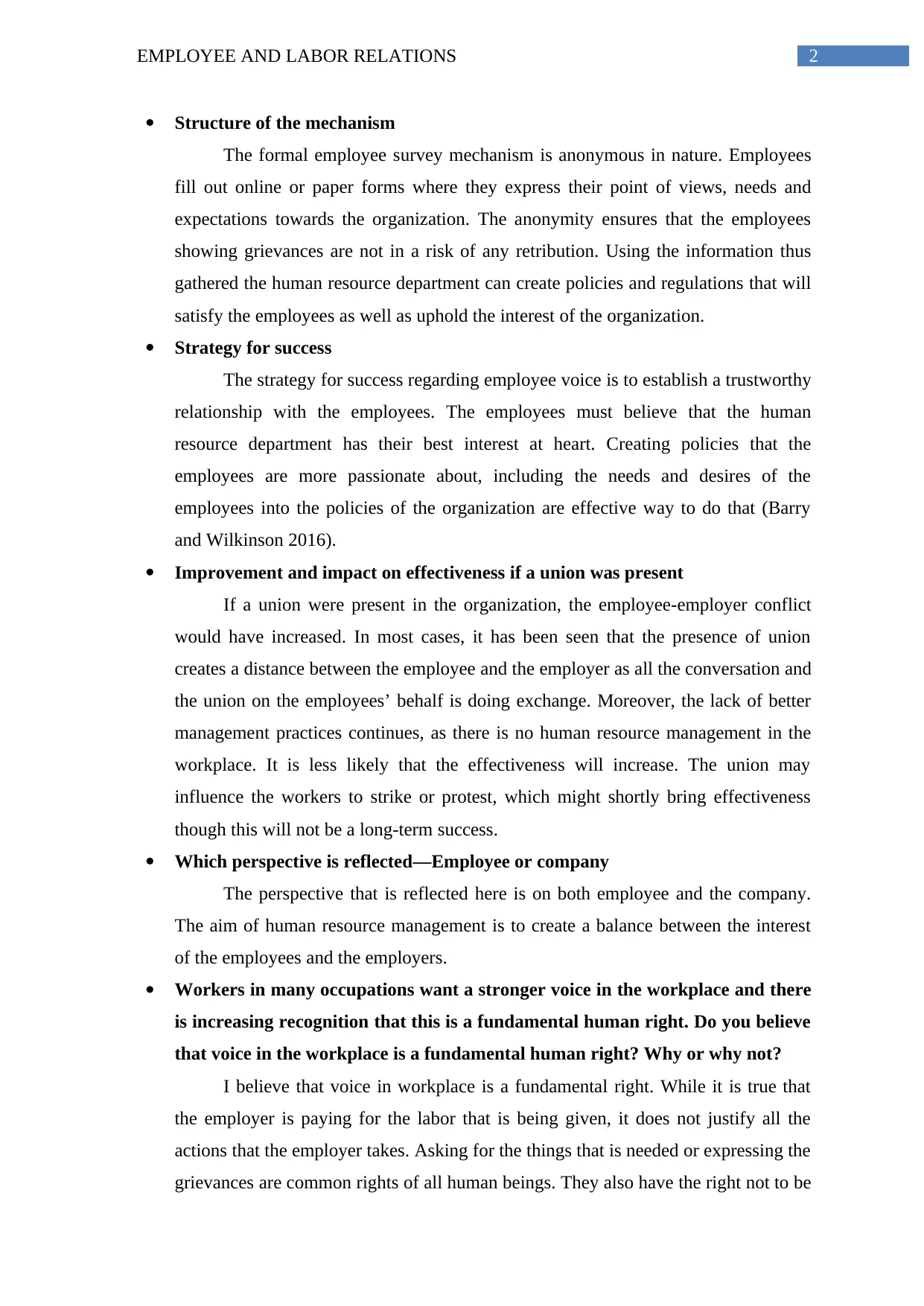
2EMPLOYEE AND LABOR RELATIONS
Structure of the mechanism
The formal employee survey mechanism is anonymous in nature. Employees
fill out online or paper forms where they express their point of views, needs and
expectations towards the organization. The anonymity ensures that the employees
showing grievances are not in a risk of any retribution. Using the information thus
gathered the human resource department can create policies and regulations that will
satisfy the employees as well as uphold the interest of the organization.
Strategy for success
The strategy for success regarding employee voice is to establish a trustworthy
relationship with the employees. The employees must believe that the human
resource department has their best interest at heart. Creating policies that the
employees are more passionate about, including the needs and desires of the
employees into the policies of the organization are effective way to do that (Barry
and Wilkinson 2016).
Improvement and impact on effectiveness if a union was present
If a union were present in the organization, the employee-employer conflict
would have increased. In most cases, it has been seen that the presence of union
creates a distance between the employee and the employer as all the conversation and
the union on the employees’ behalf is doing exchange. Moreover, the lack of better
management practices continues, as there is no human resource management in the
workplace. It is less likely that the effectiveness will increase. The union may
influence the workers to strike or protest, which might shortly bring effectiveness
though this will not be a long-term success.
Which perspective is reflected—Employee or company
The perspective that is reflected here is on both employee and the company.
The aim of human resource management is to create a balance between the interest
of the employees and the employers.
Workers in many occupations want a stronger voice in the workplace and there
is increasing recognition that this is a fundamental human right. Do you believe
that voice in the workplace is a fundamental human right? Why or why not?
I believe that voice in workplace is a fundamental right. While it is true that
the employer is paying for the labor that is being given, it does not justify all the
actions that the employer takes. Asking for the things that is needed or expressing the
grievances are common rights of all human beings. They also have the right not to be
Structure of the mechanism
The formal employee survey mechanism is anonymous in nature. Employees
fill out online or paper forms where they express their point of views, needs and
expectations towards the organization. The anonymity ensures that the employees
showing grievances are not in a risk of any retribution. Using the information thus
gathered the human resource department can create policies and regulations that will
satisfy the employees as well as uphold the interest of the organization.
Strategy for success
The strategy for success regarding employee voice is to establish a trustworthy
relationship with the employees. The employees must believe that the human
resource department has their best interest at heart. Creating policies that the
employees are more passionate about, including the needs and desires of the
employees into the policies of the organization are effective way to do that (Barry
and Wilkinson 2016).
Improvement and impact on effectiveness if a union was present
If a union were present in the organization, the employee-employer conflict
would have increased. In most cases, it has been seen that the presence of union
creates a distance between the employee and the employer as all the conversation and
the union on the employees’ behalf is doing exchange. Moreover, the lack of better
management practices continues, as there is no human resource management in the
workplace. It is less likely that the effectiveness will increase. The union may
influence the workers to strike or protest, which might shortly bring effectiveness
though this will not be a long-term success.
Which perspective is reflected—Employee or company
The perspective that is reflected here is on both employee and the company.
The aim of human resource management is to create a balance between the interest
of the employees and the employers.
Workers in many occupations want a stronger voice in the workplace and there
is increasing recognition that this is a fundamental human right. Do you believe
that voice in the workplace is a fundamental human right? Why or why not?
I believe that voice in workplace is a fundamental right. While it is true that
the employer is paying for the labor that is being given, it does not justify all the
actions that the employer takes. Asking for the things that is needed or expressing the
grievances are common rights of all human beings. They also have the right not to be
⊘ This is a preview!⊘
Do you want full access?
Subscribe today to unlock all pages.

Trusted by 1+ million students worldwide
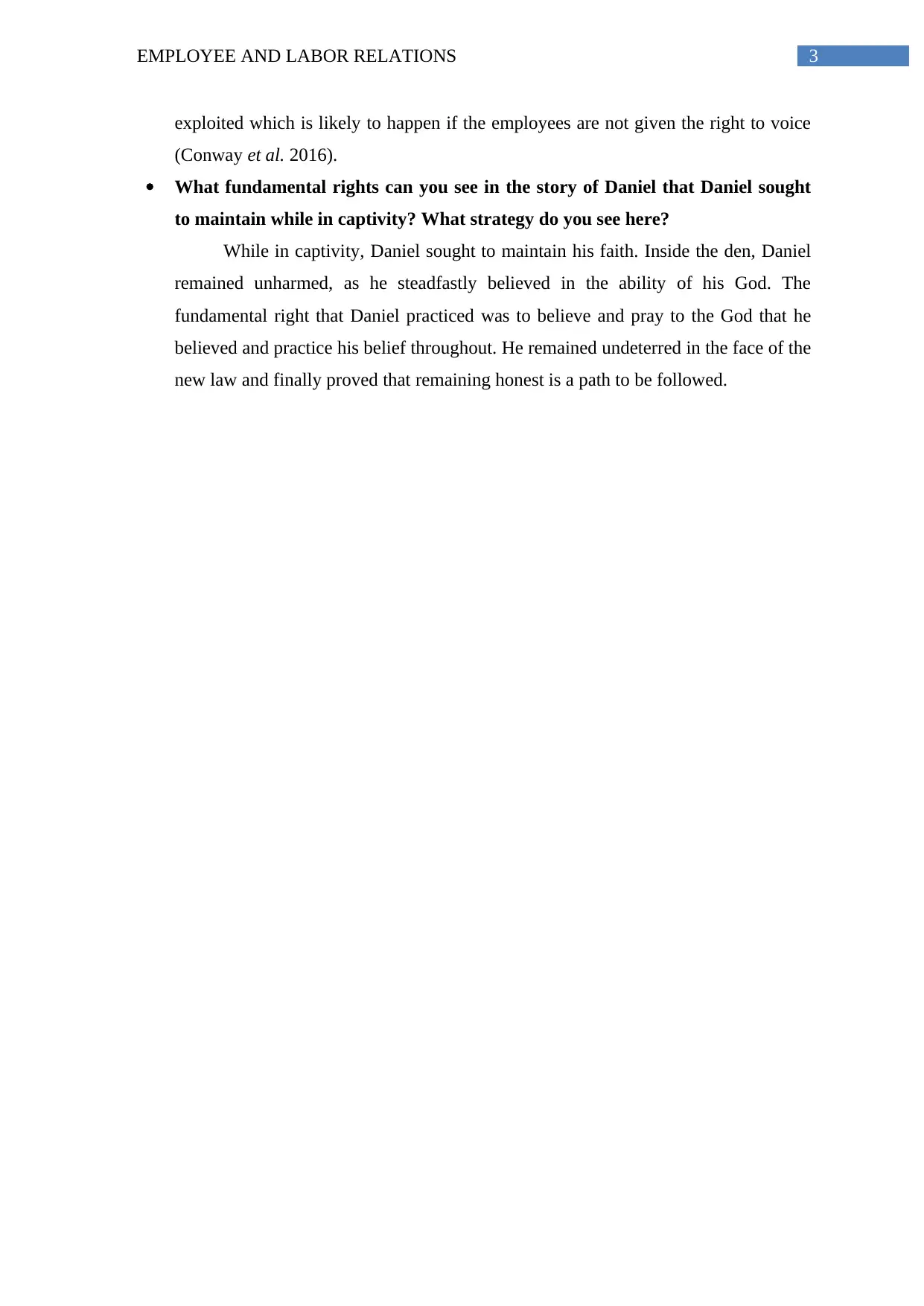
3EMPLOYEE AND LABOR RELATIONS
exploited which is likely to happen if the employees are not given the right to voice
(Conway et al. 2016).
What fundamental rights can you see in the story of Daniel that Daniel sought
to maintain while in captivity? What strategy do you see here?
While in captivity, Daniel sought to maintain his faith. Inside the den, Daniel
remained unharmed, as he steadfastly believed in the ability of his God. The
fundamental right that Daniel practiced was to believe and pray to the God that he
believed and practice his belief throughout. He remained undeterred in the face of the
new law and finally proved that remaining honest is a path to be followed.
exploited which is likely to happen if the employees are not given the right to voice
(Conway et al. 2016).
What fundamental rights can you see in the story of Daniel that Daniel sought
to maintain while in captivity? What strategy do you see here?
While in captivity, Daniel sought to maintain his faith. Inside the den, Daniel
remained unharmed, as he steadfastly believed in the ability of his God. The
fundamental right that Daniel practiced was to believe and pray to the God that he
believed and practice his belief throughout. He remained undeterred in the face of the
new law and finally proved that remaining honest is a path to be followed.
Paraphrase This Document
Need a fresh take? Get an instant paraphrase of this document with our AI Paraphraser
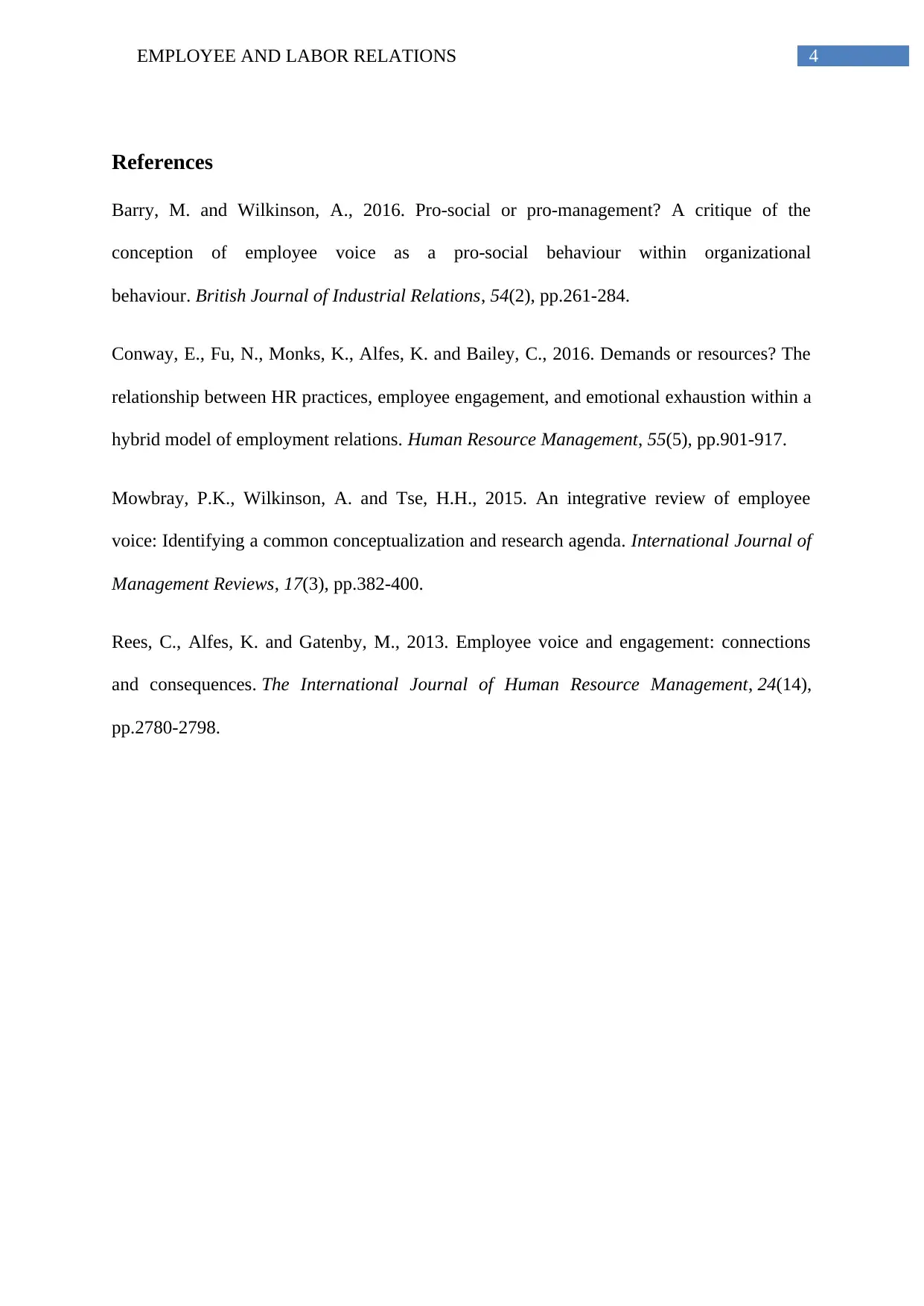
4EMPLOYEE AND LABOR RELATIONS
References
Barry, M. and Wilkinson, A., 2016. Pro‐social or pro‐management? A critique of the
conception of employee voice as a pro‐social behaviour within organizational
behaviour. British Journal of Industrial Relations, 54(2), pp.261-284.
Conway, E., Fu, N., Monks, K., Alfes, K. and Bailey, C., 2016. Demands or resources? The
relationship between HR practices, employee engagement, and emotional exhaustion within a
hybrid model of employment relations. Human Resource Management, 55(5), pp.901-917.
Mowbray, P.K., Wilkinson, A. and Tse, H.H., 2015. An integrative review of employee
voice: Identifying a common conceptualization and research agenda. International Journal of
Management Reviews, 17(3), pp.382-400.
Rees, C., Alfes, K. and Gatenby, M., 2013. Employee voice and engagement: connections
and consequences. The International Journal of Human Resource Management, 24(14),
pp.2780-2798.
References
Barry, M. and Wilkinson, A., 2016. Pro‐social or pro‐management? A critique of the
conception of employee voice as a pro‐social behaviour within organizational
behaviour. British Journal of Industrial Relations, 54(2), pp.261-284.
Conway, E., Fu, N., Monks, K., Alfes, K. and Bailey, C., 2016. Demands or resources? The
relationship between HR practices, employee engagement, and emotional exhaustion within a
hybrid model of employment relations. Human Resource Management, 55(5), pp.901-917.
Mowbray, P.K., Wilkinson, A. and Tse, H.H., 2015. An integrative review of employee
voice: Identifying a common conceptualization and research agenda. International Journal of
Management Reviews, 17(3), pp.382-400.
Rees, C., Alfes, K. and Gatenby, M., 2013. Employee voice and engagement: connections
and consequences. The International Journal of Human Resource Management, 24(14),
pp.2780-2798.
1 out of 5
Related Documents
Your All-in-One AI-Powered Toolkit for Academic Success.
+13062052269
info@desklib.com
Available 24*7 on WhatsApp / Email
![[object Object]](/_next/static/media/star-bottom.7253800d.svg)
Unlock your academic potential
Copyright © 2020–2025 A2Z Services. All Rights Reserved. Developed and managed by ZUCOL.




